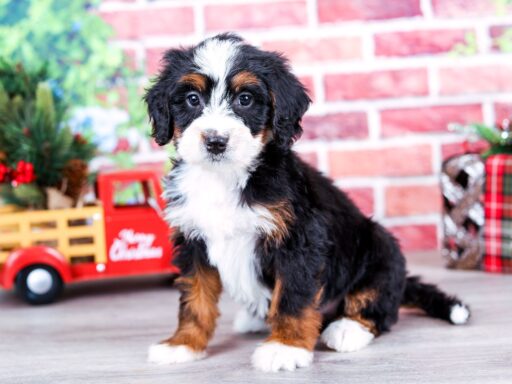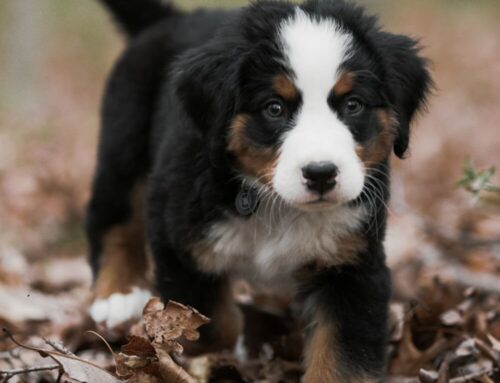Mini Bernedoodles, a unique blend of the Bernese Mountain Dog and the Poodle, have captured the hearts of many with their irresistible charm, cuddly size, and playful personalities. These intelligent and affectionate dogs are quickly becoming popular choices for families and individuals seeking a loyal and loving companion.
If you’re considering getting a Mini Bernedoodle, you’re in a good place. Let’s explore their unique characteristics, care requirements, and suitability as your next furry friend.
Table of Contents
Short Summary
- Mini Bernedoodles are a charming blend of Bernese Mountain Dog and Poodle.
- They are affectionate, playful, and intelligent companions.
- With a compact Bernedoodle mini size (13-22 inches tall, 20-40 pounds), they are ideal for various living situations.
- Mini Bernedoodles thrive on daily exercise, mental stimulation, and regular grooming, and respond well to positive reinforcement training.
- If you’re thinking of getting a Mini Bernedoodle, choose a reputable breeder who prioritizes health and ethical breeding practices.

Temperament and Personality
Mini Bernedoodles are renowned for their friendly and affectionate nature. They inherit the gentle and loyal disposition of the Bernese Mountain Dog, coupled with the intelligence and playfulness of the Poodle. These traits make them excellent companions for families with children, offering endless cuddles and playful adventures.
They are eager to please their owners and highly trainable due to their intelligence and desire to learn. Early socialization and positive reinforcement training are crucial for shaping good behavior and ensuring a well-adjusted companion.
Mini Bernedoodle – Size and Appearance
Mini Bernedoodles inherit features from both parent breeds – a Bernese Mountain Dog and a Poodle – resulting in a fascinating combination. Their size falls within the “mini” category – the size of Mini Bernedoodle typically ranges from 13 to 22 inches tall at the shoulder and weighs between 20 and 40 pounds.
Their hypoallergenic coats can be wavy, curly, or somewhere in between, with a variety of colors including tri-color (black, white, and brown), black and white, brown and white, and even solid colors like red or chocolate.
Exercise Needs
Mini Bernedoodles are energetic and playful dogs, requiring daily exercise to stay physically and mentally stimulated. Aim for at least 30-60 minutes of combined activity each day. This can be divided into several shorter sessions throughout the day, catering to their shorter attention spans as puppies and preventing boredom and destructive behaviors.
Here are some diverse options for providing your Mini Bernedoodle with the exercise they need:
- Walks: Regular walks are a great way to fulfill their exercise needs while providing mental stimulation through new sights and smells. Explore different routes and parks to keep them engaged.
- Playtime: Engage your Mini Bernedoodle in interactive play sessions using fetch toys, frisbees, or tug-of-war ropes. This burns excess energy, strengthens your bond, and provides fun mental stimulation.
- Dog parks (with supervision): Supervised visits to dog parks allow them to socialize with other canine companions and engage in off-leash play, promoting healthy social interaction and exercise.
- Dog sports and activities: Consider exploring activities like agility courses, obedience training, or canine swimming pools. These activities provide physical and mental challenges, keeping your Mini Bernedoodle engaged and offering opportunities to bond through shared experiences.
- Indoor activities: During bad weather or limited outdoor space, engage your Mini Bernedoodle in indoor activities like playing hide-and-seek, using puzzle feeders, or practicing basic obedience commands.
Remember to adjust the intensity and duration of exercise based on your Mini Bernedoodle’s age and individual energy level. Consult your veterinarian for personalized recommendations on an appropriate exercise plan for your furry friend.
Grooming
The grooming needs of Mini Bernedoodles vary depending on their coat type. Here’s a breakdown for the two most common coat types:
- Curly Coat: This coat requires the most attention, demanding regular brushing (2-3 times a week) to prevent matting and maintain a healthy appearance. Use a slicker brush and a dematting comb to gently remove any tangles or matted fur. Regular bathing (every 8-12 weeks) using a gentle dog shampoo formulated for curly coats is recommended. After bathing, thoroughly dry the coat with a towel and blow dryer on a low setting, directing airflow in the direction of hair growth to prevent matting. Trimming may also be necessary every few months to maintain a desired length and style.
- Straight or Wavy Coat: While requiring less maintenance than curly coats, straight or wavy coats still need regular brushing (1-2 times a week) to remove loose hair and prevent matting. Occasional bathing (every 3-4 months) with a gentle dog shampoo is sufficient for this coat type. Trimming is optional but can be done to maintain a neat appearance.
In addition, make sure to incorporate such grooming habits as:
- Ear cleaning: Regularly clean your Mini Bernedoodle’s ears with a gentle ear cleaner and cotton balls to prevent ear infections.
- Nail trimming: Regularly trim your Mini Bernedoodle’s nails to prevent them from getting too long and uncomfortable or causing damage to your floors or furniture. You can use dog nail clippers or consult a groomer for assistance.
- Dental hygiene: Brush your Mini Bernedoodle’s teeth regularly with dog-specific toothpaste to maintain good oral health and prevent dental problems.
Feeding
Feeding your puppy properly is crucial for their health and well-being. Opt for high-quality dog food specifically formulated for their age, activity level, and size. Consult your veterinarian for personalized dietary recommendations based on your individual dog’s needs.
In addition, pay attention to such factors as:
- Puppy vs. Adult Food: Puppies require a different nutritional balance than adult dogs. Ensure you transition them to adult food gradually around the one-year mark, following the feeding guidelines on the chosen food’s packaging.

- Portion Control: Overfeeding can lead to obesity, which can contribute to various health problems. Stick to the recommended serving sizes based on your dog’s age, weight, and activity level.
- Dietary Restrictions: Some Mini Bernedoodles may have food allergies or sensitivities. In such cases, consult your veterinarian to identify the source of the issue and choose a hypoallergenic or limited-ingredient diet.
- Treats: While occasional treats are perfectly acceptable, they should not constitute a significant portion of your dog’s daily calorie intake. Choose healthy treats like fruits, vegetables, or commercially available low-calorie options.
Training and Socialization
Mini Bernedoodles are eager to please and highly intelligent, making them relatively easy to train. However, successful training requires dedication, patience, and consistency.
Here are some key aspects of training and socialization for your Mini Bernedoodle:
- Start early: Begin training and socializing your puppy as early as possible, ideally during the crucial puppy socialization window (between 3-16 weeks of age). This is when puppies are most receptive to learning and forming positive associations with new people, animals, and environments.
- Positive reinforcement: Use positive reinforcement methods like treats, praise, and play to reward desired behaviors. This approach is more effective and builds a stronger bond with your dog compared to punishment-based methods.
- Consistency is key: Use consistent commands, routines, and expectations when training your puppy to help them understand what is expected of them. This consistency helps them learn faster and develop good habits.
- Professional guidance: Consider enrolling in puppy classes or seeking guidance from a professional dog trainer, especially if you encounter any challenges. They can provide valuable insights and personalized training plans tailored to your dog’s needs.
- Socialization beyond puppyhood: Socialization is an ongoing process that continues throughout your dog’s life. Expose your Mini Bernedoodle to various people, animals, and environments in a positive and controlled manner. This helps them become confident and well-adjusted dogs around different stimuli.
Health and Lifespan of a Mini Bernedoodle
The average lifespan of a Bernedoodle is 12-15 years. Mini Bernedoodles are generally healthy dogs, however, like all breeds, they are predisposed to certain conditions inherited from their parent breeds. These can include:
- Hip dysplasia: a malformation of the hip joint
- Elbow dysplasia: a similar condition affecting the elbow joint
- Patellar luxation: kneecap dislocation
- Eye problems: cataracts and progressive retinal atrophy
How to Choose Your Perfect Mini Bernedoodle?
Before welcoming a Mini Bernedoodle into your family, thorough research and responsible breeder selection are crucial. Look for a reputable Bernedoodle breeder who prioritizes the health and well-being of their dogs. Here are some key factors to consider:
- Reputation: Choose a breeder with a positive reputation for ethical breeding practices and prioritizing the health of their dogs.
- Health testing: Ensure the breeder performs health clearances on the parent dogs for common conditions relevant to the breed.
- Living conditions: Visit the breeder’s facility to ensure the dogs are well-cared for and kept in a clean and healthy environment.
- Puppy selection: Observe the puppy’s temperament and choose one that demonstrates good socialization and isn’t shy or aggressive.
Bringing Your Mini Bernedoodle Home – Key Steps
Once you’ve welcomed your Mini Bernedoodle puppy home, prepare for a whirlwind of love, laughter, and learning. Here are some of the essential steps to ensure a smooth transition:
- Puppy-proofing: Secure your home by removing any potential hazards like electrical cords, toxic plants, and any other objects that may be harmful to your puppy.
- Crate training: Crate training provides your puppy with a safe and secure space to relax and rest. Start slowly, gradually increasing the amount of time spent in the crate and making it a positive experience with treats and toys.
- Potty training: Be consistent with potty breaks, taking your puppy outside frequently, especially first thing in the morning, after meals, and before bedtime. Reward them with praise and treats for successful elimination outdoors.
- Establishing routines: Create consistent routines for feeding, walking, playtime, and bedtime. This predictability helps puppies feel secure and adjust to their new environment.
- Ongoing socialization: Continue socialization efforts by taking your puppy on walks to meet new people and dogs, attending puppy classes, and inviting friends and family over.
Extra Activities
Living with a Mini Bernedoodle is more than just providing basic needs. Consider these additional aspects to enrich their lives and strengthen your bond:
- Mental stimulation: Offer your Mini Bernedoodle interactive toys, food puzzles, and scent work activities to challenge their minds and prevent boredom.
- Positive reinforcement training: Continue training throughout your Mini Bernedoodle’s life, focusing on new tricks and reinforcing good manners. Use positive reinforcement methods like treats, praise, and clicker training.
- Travel and adventures: Mini Bernedoodles are adaptable and can accompany you on various excursions, making them excellent travel companions for dog-friendly adventures.
Potential Challenges Related With Owning a Mini Bernedoodle
While Mini Bernedoodles are generally considered easygoing and well-suited for families, some challenges might arise:
- Separation anxiety: Some Mini Bernedoodles may experience separation anxiety if left alone for extended periods. Consider crate training, providing stimulating toys before leaving, and gradually increasing the amount of time spent alone.
- Barking: Excessive barking can be a nuisance. Training and addressing the underlying causes, such as boredom, separation anxiety, or seeking attention, are crucial for mitigating this behavior.
- Destructive chewing: Puppies naturally explore the world through chewing. Provide them with safe chew toys and redirect them if they start chewing inappropriate items.
If you encounter any challenges with your Mini Bernedoodle, remember not to resort to harsh methods. Positive reinforcement training, along with consulting professional dog trainers or animal behaviorists, can go a long way in resolving behavioral issues.
The Bottom Line
Mini Bernedoodles are captivating companions offering a delightful combination of love, loyalty, and playfulness. With their adaptable nature and manageable size, they are suitable for various living situations.
However, remember that owning any dog requires a significant commitment of time, resources, and responsibility. By understanding their needs, providing proper care and training, and showering them with love, you can build a strong and rewarding lifelong bond with your Mini Bernedoodle.











